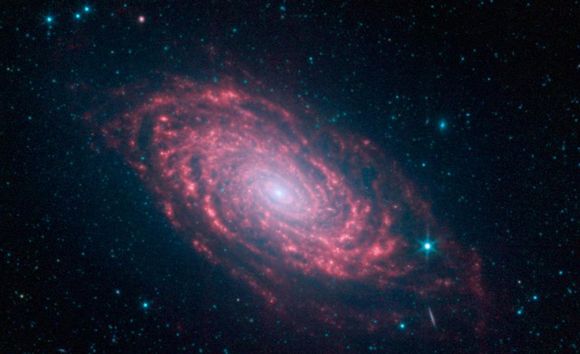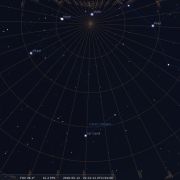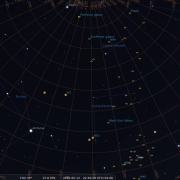In our tour of stellar objects crossing the meridian line this month: Charles's Heart, a star in the 'Hunting Dogs' constellation, 'Canes Venatici', and the 'Sunflower Galaxy' a spiral galaxy in the same constellation.
Star: Cor Coroli or ‘Charles's Heart’ in Canes Venatici
Telescope (min. 3" diameter), Easy
Alpha Canum Venaticorum had no name until the 17th century, when it was named Cor Caroli, which means "Charles's Heart". Uncertainty surrounds whether it was named in honour of King Charles I of England, or his son, Charles II, who restored the English monarchy to the throne in 1660. The name was coined in 1660, allegedly by Sir Charles Scarborough, physician to Charles II, who claimed the star seemed to shine exceptionally brightly on the night of Charles II's return to England. In Star Tales, Ian Ridpath points out that the name's first appearance on a star map was in the 1673 chart of Francis Lamb, who labelled it Cor Caroli Regis Martyris ('the heart of Charles the martyred king'), clearly indicating that it was seen as referring to Charles I, so take your pick.
Alpha Canum Venaticorum is a binary star with a combined apparent magnitude of 2.81. The two stars are 19.6 arcseconds apart, which means they are easily resolved in small telescopes. The system lies approximately 110 light years from the Sun. The main component has a spectral type of A0, and is slightly variable (mag 2.84 and 2.98) over a period of 5.47 days and is the prototype of a class of variable stars, the so-called α2 Canum Venaticorum variables. It has a strong magnetic field, some 5,000 times that of Earth's, which are thought to produce huge stars pots causing the variability as the star rotates. The secondary component is a F-type main sequence star. It is considerably fainter than its companion and has an apparent visual magnitude of approximately 5.60. To locate Canes Venatici and its chief star Cor Coroli look below the handle of the Plough. The two main stars in the constellation are relatively distinct. Cor Coroli crosses the south meridian line high up on May 13th at 10:30pm. You will require at least a 3 inch aperture to split Cor Coroli itself. Easy

Star: Cor Coroli in Canes Venatici ('Hunting Dogs), (Image: F Ringwald, Fresno State Campus Obs.)
Galaxy: Sunflower galaxy - M63 or NGC 5055
Telescope, Medium
There are so many galaxies which cross due south at some point in May – you could pick anyone from a couple of dozen. I have chosen
The hunting dogs of Canes Venatici may only be a small constellation, but it contains a number of deep sky objects worthy of attention. One such object M63 or NGC 5055, the Sunflower Galaxy, was discovered by Pierre Méchain, Charles Messier’s friend and colleague, in June 1779, Méchain’s first discovery. Lord Rosse observed the spiral structure of M63 in the mid 19th century, being one of the first galaxies in which structure was clearly seen.
Today’s modern imaging devices reveal the Sunflower galaxy as one of the most beautiful of the messier galaxies. M63 is around 98,000 light years across and contains an estimated 140 billion solar masses. The galaxy has an apparent magnitude of 9.3, lies at a distance of approximately 27 million light years from Earth. It is a member of the M51 Group, a group of galaxies in Canes Venatici that also includes the more famous Whirlpool Galaxy, Messier 51, the brightest galaxy in the group. A Type Ia supernova, SN 1971I, triggered by a violent explosion of a white dwarf, was detected in the galaxy on May 25, 1971. It was observed in one of the spiral arms and reached a peak magnitude of 11.8.
The Sunflower Galaxy has extended features that may have formed as a result of interactions with neighbouring galaxies. The extended structure stretches far beyond the bright extent of the galaxy’s normal spiral arms and more than doubles M63’s true extent. The Galaxy is believed to have a super massive black hole with a mass of up to 30 million

'Sunflower Galaxy' (NGC 5055) (using NASA Spitzer Telescope)
- Log in to post comments



